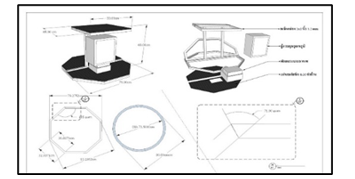Effects of Using a Temperature Control System in Bandicota indica Stalls with Internet of Things Technology
Main Article Content
Abstract
In Thailand, the Bandicota indica is one of livestock with a market demand for consumption, as it can be used to make a variety of dishes and has good taste [1]. Nowadays, farmers have started to raise more and more people, resulting in an idea to develop a farming system that is efficient and yields the most value. This research aims 1) to develop prototype of a temperature control system in Bandicota indica stall with Internet of Things technology and 2) to compare the compare growth of Bandicota indica between using a temperature control system and traditional systems. Samplings were 30 Bandicota indica at age of 2 months which divided to 15 male and 15 female by raising according to sex, 5 Bandicota indica per stall (separate genders), totaling 6 stalls. The instruments used in the experiment were two stalls equipped with a temperature control system prototype (Type 1 and 2) and a one stall that was not equipped with a temperature control system prototype (Type 3). The Bandicota indica s' growth data were analyzed by comparing the differences in growth rates in the 3 Types: body weight (Kilograms), body length (Centimeters) and analyze production costs and returns. The results showed that 1) the temperature control system prototype consisted of temperature and humidity sensor and the ventilation fan uses the Sonoff th 16 Sensor DS18B20 device to monitor the temperature to be between 26-30 °C and control the opening of the ventilation fan when the temperature exceeds the set value through the application eWeLink. And 2) The growth rate of Bandicota indica in Type 1 of both sexes was higher than that of Bandicota indica in Type 2 and 3 up to 2 times.
Article Details
References
The Agricultural Research Development Agency, “Economic animals: An animal that has been making money for Thai people for a long time,” 2020. Available: https://www.arda.or.th/knowledge_detail.php?id=39. [Access Sep. 20, 2022].
T. Visitpanich, General principles of animal production, Chiang Mai : Chiang Mai University Press, pp. 13, 1985
Sukhothai Thammathirat Open University, Teaching Document on Farm Management Course, Bangkok: Chuan Pim Printing House, 2002.
A. Villa-Henriksen, G. T.C. Edwards, L. A. Pesonen, O. Green, C. A. G. Sørensen, Internet of Things in arable farming: Implementation, applications, challenges and potential, Biosystems Engineering, vo. 191, pp. 60-84, 2020
B. Kongsuk, “Innovation development of native chicken farm management to improve the productivity and value added in standard marketing for small-scale farmer.” B.S. Thesis, Naresuan University, Phitsanulok, Thailand, 2020.
V. Sittakul, G. Phanomchoeng, L. Wuttisittikulkij, W. Asdonwised, and C. Phongphanphanee, “Development Project of Smart Pig Farm Using LoRaWAN.” NBTC Journal. pp. 215-236, 2021.
U. Kanto. “Analysis of the marketing of pork meat of pig farming cooperatives.” Kasetsart Livestocks Magazine (Thailand), vol. 40, no. 158, pp. 21-29, 2013.
S. Kaskasem, Influence of environmental temperature on fattening pig performance. Kasetsart University, Ministry of Agriculture and Cooperatives, Bangkok, 1988.
C. Vajrabukka, S. Chomchai, and S. Kaskasem, Influence of environmental temperature on fattening pig performance. Annual Research Report 1987-1988, National Swine Farming Research and Training Center, 1988.
W. Woraserm, L. Chantabut, and S. Pimratch, “Effect of temperature on reproductive performance of crossbred frogs in the winter season.” Prawarun Agricultural Journal. Vo. 16, no. 2, pp. 339 – 348, 2019.
C. Limsuwan, S. Wongmaneeprateep, S. Prasertsri, K. Limhang, P. Wiriyapattanasub, K. Laisutisan, and A. Srimarksuk, “Effect of temperature on feed intake, growth, survival rate and water qualities in rearing of Pacific white shrimp (Litopenaeus vannamei),” In Proc. 48th Kasetsart University Annual Conference: Fisheries, 2020, pp. 313-321.
Y. Chaiseha, I. Rozenboim, N. Sartsoongnoen, and S. Kosonsiriluk, Effects of Ambient Temperature upon the Neuroendocrine Regulation and the Mechanism(s) Mediating the Reproductive Cycle of the Female Native Thai Chicken: Roles of Steroid Hormones. Institute of Science, Suranaree University of Technology, Nakhon Ratchasima, 2011.
K. Dongsongkram, S. Punpitak, P. Premto, and T. Trisakul, “The Development of environment control system using Internet of Things technology in Green House Via Cockfighting,” Journal of Applied Information Technology, vol 8, no. 1, pp.103-116, 2022.
T. Pothong, P. Mekarun, and S. Choosumrong, “Development of Smart Farming Service System for Smart Farmer using FOSS4G and IoT,” Naresuan Agriculture Journal, vol. 16, no. 2, pp. 10-17, 2019.
R. Ruangkarn, N. Sae Jong, and C. Rattanach, “The System Controls Environment of Earthworm with IoT Platform.” Princess of Naradhiwas University Journal, vo. 13, no. 3, pp. 294-307, 2021.

